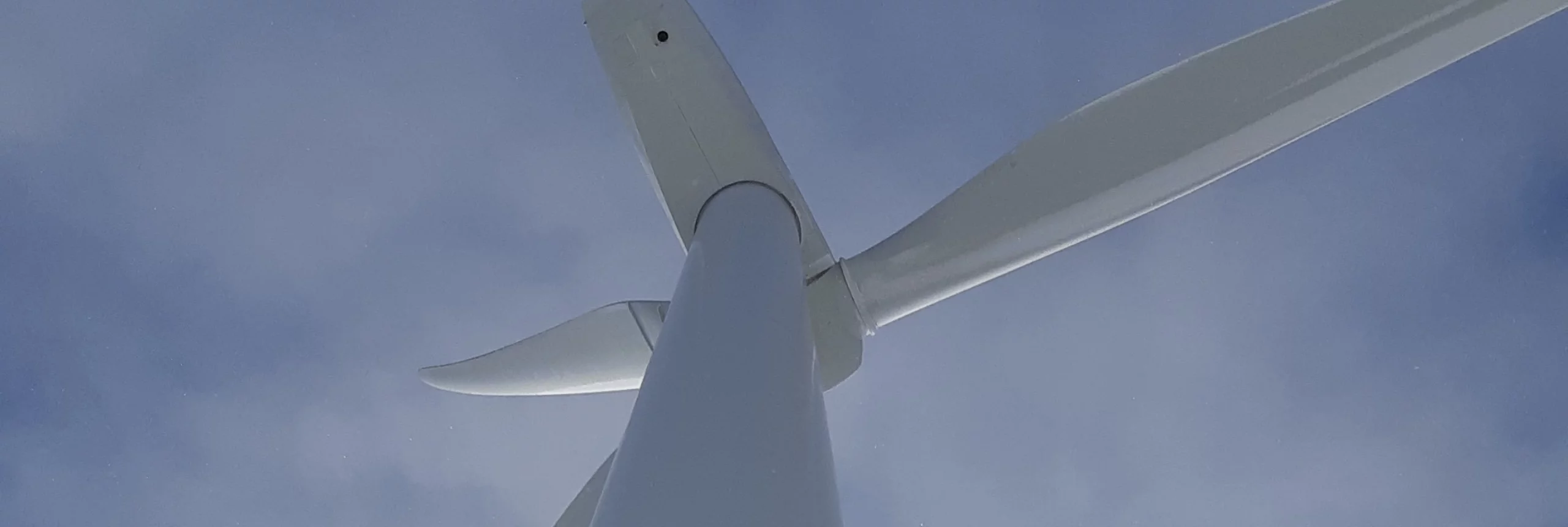
News
How to Track Losses from Ice Build-Up on Wind Turbines
Wind energy production plays a crucial role in meeting electricity demands and reducing reliance on fossil fuels. Areas with cold climates like Canada, Scandinavia, and Nordic regions experience strong winter winds, making them ideal locations for wind farms. Additionally, freezing temperatures and humidity pose significant challenges to wind turbine operations.

Daniela Roeper
Vice President BorealisWind
When ice builds up on wind turbine blades, it disrupts the aerodynamic profile of the blades, increasing drag, reducing lift, and thus reducing their efficiency in capturing wind energy. This results in decreased power output from the affected turbines, reducing the overall energy production capacity of the wind farm. In some cases, the turbines come to a standstill and stop producing valuable energy altogether.
Additionally, ice accumulation can lead to imbalances in the rotor system, causing mechanical stress and potential damage to critical components such as the blades, main shaft, bearings, gearbox, tower and foundations. The impact of icing on wind turbine blades not only affects energy generation but could increase maintenance costs, reducing the lifespan of the turbine while posing safety risks to personnel and property around the turbines.
Understanding Ice Build-Up on Wind Turbine Blades
Ice forms on wind turbine blades due to specific atmospheric conditions that are prevalent in cold climates. When temperatures drop below freezing, small water droplets (micron-size) in the air stay in a supercooled liquid form and freeze upon impact on surfaces and structures. This is how ice accretes and adheres to the surface of the turbine blades. This moisture can originate from freezing rain, or fog, which are common occurrences in colder regions. During freezing rain events, water droplets in the air freeze on blade surfaces. This can occur after a significant amount of time leading to an icing effect called runback. This effect can be observed as the formation of icicles. Additionally, melting snow can also accumulate on the blades, further exacerbating the ice formation and accumulation.
Temperature fluctuations play a significant role in the formation of ice on turbine blades. Rapid changes in temperature can cause melted ice to refreeze, leading to thicker and more stubborn layers of ice. Wind speed influences ice formation by increasing moisture on the blades. Higher wind speeds can drive moisture-laden air onto the blades, accelerating the process of ice accretion. As a result, the combination of freezing temperatures, moisture in the air, temperature fluctuations, and wind speed create conducive conditions for ice formation on wind turbine blades, posing challenges for energy production and turbine performance.
Ice accumulation on wind turbine blades can also create safety hazards for maintenance personnel and surrounding areas. Falling ice chunks from spinning blades can endanger workers and equipment below, while ice shedding during thawing conditions can pose risks to nearby infrastructure and personnel. Therefore, the adverse effects of ice build-up on wind turbine performance extend beyond reduced energy production to include mechanical strain and safety concerns, underscoring the importance of effective ice mitigation strategies in cold climate wind farms.
Importance of Tracking Losses from Ice Build-Up
Monitoring and tracking ice-related losses provides crucial insights into the actual energy production potential of the wind farm during the winter months when icing events are most prevalent. By understanding the extent to which ice build-up affects energy generation, wind farm operators can better forecast and manage seasonal variations in output, ensuring consistent production throughout the year.
Monitoring ice-related losses helps ensure accurate performance evaluation and predictive maintenance scheduling. By analyzing historical data on ice formation and its impact on turbine performance, operators can identify trends, anticipate potential issues, and proactively address maintenance needs to minimize downtime and maximize operational efficiency.
Armed with comprehensive data on icing events and their effects, operators can adjust operational strategies, implement mitigation solutions, and invest in technologies to enhance cold weather resilience, ultimately improving overall productivity and profitability of the wind farm.
Methods for Tracking Losses from Ice Build-Up
Meteorological Data Analysis
Meteorological Data Analysis tracks ice build-up on wind turbine blades by leveraging weather station data and correlating it with ice formation events. Weather station data provides valuable information on temperature, humidity, precipitation, and wind speed, all of which are critical factors influencing ice formation. By continuously monitoring these meteorological parameters, wind farm operators can identify conditions conducive to ice accretion on turbine blades.
By correlating historical weather data with recorded instances of ice build-up, operators can discern patterns and trends, enabling more accurate predictions of icing occurrences in the future.
Remote Sensor Technology
Remote sensing technologies offer advanced methods for tracking ice build-up on wind turbine blades, enhancing monitoring capabilities and improving operational efficiency.
One technology is LiDAR (Light Detection and Ranging), which employs laser pulses to measure distances and create high-resolution three-dimensional maps of the surrounding environment. By installing LiDAR systems on wind turbines, operators can conduct real-time monitoring of ice accumulation on turbine blades with precision and accuracy. Also, infrared imaging technology can detect variations in surface temperature indicative of ice build-up. This allows for early identification of potential icing events, enabling proactive measures to be taken to mitigate their impact.
Drones equipped with specialized cameras can be deployed to conduct close-range inspections and capture high-resolution images. These detailed visual assessments of ice accumulation can also aid in the identification of potential maintenance needs.
Condition Monitoring Systems
Condition monitoring systems offer a proactive approach to tracking ice build-up on wind turbine blades by integrating sensors and data loggers to measure blade performance parameters. These systems monitor various operational metrics such as vibration patterns, power output fluctuations, and other critical data. By using sensors on wind turbines, operators can collect real-time data on blade condition and detect issues associated with ice build-up. For instance, changes in vibration patterns or power output fluctuations may indicate the presence of ice on turbine blades, signaling potential efficiency losses.
On-premise Ice Measurement
Presently, ice detection sensors are available to be installed directly on wind turbines and provide helpful insights on the occurrence, prevalence and intensity of icing events. This approach is the most accurate method of tracking ice-related losses.
These systems allow operators to identify ice-related issues early and implement de-icing strategies to mitigate their impact and continue generating valuable energy. Condition monitoring systems enable continuous monitoring of turbine performance to minimize downtime and maximize energy production.
Detecting and Preventing Ice Build-Up
Proactive strategies play a pivotal role in minimizing ice-related production losses and maximizing wind turbine production.
One strategy involves the application of anti-icing and heating systems in turbine blades. These systems prevent ice formation and facilitate the removal of ice already accumulated on the blades. The most effective blade heating solutions ensure heat reaches the tip of the blade, an effective solution for combating ice build-up during critical icing conditions. These heating systems are activated automatically when sensors detect icing events, preventing the formation of ice or facilitating rapid melting, to protect turbine performance and reliability.
Another strategy is to regularly apply specialized coatings or heating elements to the blade surfaces. These solutions are designed to create conditions unfavorable for ice accretion and are reapplied every 2-3 years.
By analyzing trends and patterns in weather data and turbine performance, predictive models can forecast potential icing occurrences, allowing operators to proactively implement preventive measures. The integration of proactive strategies for detecting and preventing ice build-up on turbine blades enhances operational resilience, mitigates performance losses, and maximizes energy production in cold climate wind farms.
The proactive implementation of preventive measures, such as anti-icing systems, blade heating technology, and predictive modeling can help mitigate the impact of icing events and maximize wind turbine productivity in cold climates. Considering this, cold climate wind farm executives should prioritize ice mitigation solutions, invest in innovative technologies, and foster a culture of continuous improvement to ensure consistent energy production, operational reliability, and drive profitability at their wind farm.
Additional Information
Learn more about ice protection systems
Experts in icing mitigation for wind turbines
